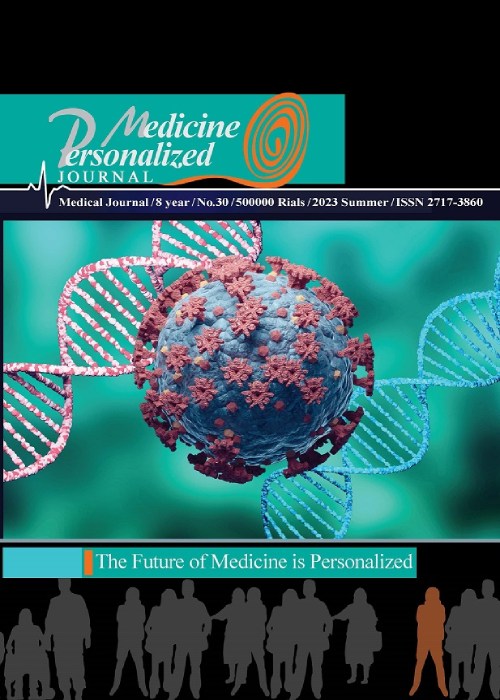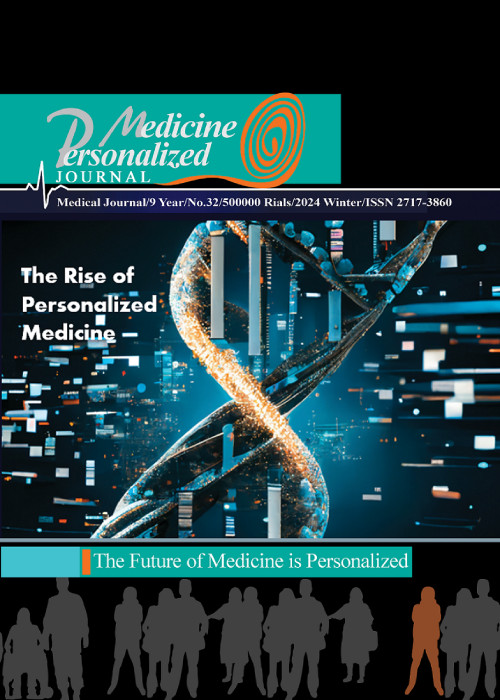فهرست مطالب

Personalized Medicine Journal
Volume:8 Issue: 30, Summer 2023
- تاریخ انتشار: 1402/07/08
- تعداد عناوین: 6
-
Pages 1-8BackgroundLots of people die from heart failure (HF) because of fibrosis formation. As injured myocytes deregulated MMP-2, MMP-4, TIMP-2, Ang, plasma renin activity (PRA), and ACE leading to fibrosis, their regulation can improve HF. One of the most effective treatments for heart failure is the use of hAMSCs-CM, which has been shown to improve heart function and reduce symptoms. The study innovation was the investigation of the in vivo mode of action of hAMSCs-CM on HF fibrosis focusing on the mentioned proteins for the first time. We expected that this study partly fill the scientific gap in HF treatment.MethodsFrothy rats were divided into 4 groups; Control, HF, culture medium, and CM. To induce HF, isoproterenol (ISO) was injected into all animals except for the control. CM were injected into the CM group and the culture medium group received culture medium. Then, cardiac functions were measured using echocardiography and serum fibrosis was evaluated by ELISA.ResultsHF model showed decreased MMP-2, MMP-4, Ang, PRA, and ACE and increased TIMP-2, whereas hAMSCs-CM therapy reversed them compared with controls.ConclusionOur result has partially filled the HF treatment’s gap as hAMSCs-CM improved cardiac function and reduced cardiac fibrosis and the serum fibrogenic proteins.Keywords: Human amniotic membrane mesenchymal stem cells, Conditioned medium, heart failure, Cardiac fibrosis
-
Pages 9-16There were more than thirty-eight million HIV infections worldwide. Combination antiretroviral therapy (cART) has progressed to the point where invisible viral loads are now feasible, and HIV carriers frequently lead almost everyday lives with considerably greater average life expectancies than in the past. However, there is still no cure for the disease. Even though the ailment usually advances to a chronic state, an individual's unique course of progression may differ significantly from the average and manifest distinctively for each patient. This diversity begs whether a typical treatment strategy is appropriate for a patient..Keywords: HIV infections, Personalized Medicine, Antiviral inhibitors, Gene-editing approach
-
Pages 17-24Exposure to low-frequency electromagnetic fields (LF-EMF) has been considered a global concern because of its harmful effects on human health (cancer, neurodegenerative disorders, etc.). According to the International Agency for Research on Cancer, EMF has been classified as a possible cancerous element for human health. Antioxidants such as vitamin C improve the damage caused by EMF by reducing oxidative stress. To evaluate the effects of EMF on the serum total protein, blood sugar, albumin and triglyceride, and the inhibitory role of vitamin C, 40 male BALB/c mice were recruited. Participants were randomly distributed into four groups 1- exposure to LF-EMF, 2- exposure to LF-EMF which received vitamin C (50 mg/kg), 3- exposure to LF-EMF which received vitamin C (100 mg/kg), and 4- control group (no exposure). The experimental groups (1-3) received LF-EMF (50 Hz, 4 mT, 4 hours/day, and 1 month) while both groups 2 and 3 had intraperitoneally injected vitamin C (50 mg/kg, 100 mg/kg) every other day basis respectively. The obtained results demonstrated higher triglyceride and total protein levels and lower albumin and blood sugar levels in the LF-EMF group compared to controls while vitamin C restricts their alterations (p<0.05). To sum it up, our data show that intraperitoneal injection of vitamin C restricts the effects of LF-EMF exposure on the biochemical parameters in mice. However, the antioxidant characteristics of vitamin C may be probably involved in the LF-EMF effects of biochemical parameters in mice.Keywords: Electromagnetic fields, Biochemical parameters, LF-EMF, Total protein levels, Vitamin C
-
Pages 25-31The enormous genetic variety of the viral population harbored by the patient and the large volume of therapeutic alternatives characterize HIV therapy. Each patient and period has its viral population. The enormous number of therapy possibilities makes selecting an ideal or near-optimal therapy challenging, especially among therapy-experienced patients. Over the last decade, computer-based medication selection that measures viral resistance to pharmaceuticals has become a norm for HIV patients. We explore the qualities of available systems and the field's viewpoints.Keywords: HIV therapy, Anti-HIV-1 Agents, HIV Medication Resistance
-
Pages 32-40BackgroundA lot of patients are suffering from asthma. For decreasing the asthma symptoms, we studied the effects of conditioned medium (CM) of human amniotic membrane mesenchymal stem cells (hAM-MSCs) as a source of anti-inflammatory cytokines on splenocyte and lung tissue of asthmatic Balb/c mice.MethodsForty mice were categorized into four groups; ovalbumin (OVA)-induced asthma, CM-treated asthma, DMEM (Dulbecco's Modified Eagle Medium)-treated asthma, and saline control. Each group received related treatment. The lung alpha-smooth muscle actin (α-SMA) and splenocyte inflammatory cytokines and IgE were examined through Western blot analysis.ResultsWestern blot showed α-SMA overexpression in the OVA and DMEM groups compared with the saline group. CM therapy could significantly reverse it compared with OVA and OVA+DMEM categories by elevating IL-10 and IFN-γ and reducing IL-4, IgE, and TGF-β .ConclusionCM treatment could improve asthma symptoms by adjusting α-SMA in lung tissue and pro-inflammatory cytokines and IgE in splenocytes.Keywords: Asthma, Alpha-smooth muscle actin, Mesenchymal stem cell
-
Pages 41-47ObjectivesDiabetes mellitus type 1 (T1DM), which is also an autoimmune disorder, can coexist alongside other types of autoimmune diseases. This study aimed to investigate the possibility of a subclinical association between diabetes disease and autoimmune thyroid dysfunction. The clinical condition of the patient and their approach to managing their diabetes were specifically considered when deciding whether or not the patient had autoantibodies.MethodsThis study included sixty individuals who were diagnosed with diabetes type 1. (thirty males and thirty women, with a mean age of 21.04 years) and 30 healthy controls (12 males and 18 females).ResultsDiabetics had considerably greater serum IL-10, IL-6, and TNF-α levels than healthy controls. Stepwise regression indicated significant positive correlations between IL-10, IL-6, and TNF-α with these antibodies and strong inversed relationships between IL-6 and Anti-TPO, Anti-TG, antibodies.. No matter if the antibodies were present or how severe they were, this held true. The study's findings lend credence to the idea that people with type 1 diabetes should have their thyroid antibodies and function checked.ConclusionsThyroid antibodies were most common among type 1 diabetics aged 21–35, according to our study (Anti-TPO and Anti-TG). IL-10, IL-6, and TNF-α levels in diabetic patients and controls were significantly different (P<0.01). IL-10, TNF-α, HbA1C, and body mass index positively correlated with thyroid antibodies, except for IL-6. Thyroid antibodies and functional abnormalities should be tested often in type 1 diabetics due to the high occurrence of thyroid autoimmune illnesses.Keywords: Anti-TG Antibody, Anti-TPO Antibody, IL-10, TNF-α, Type 1 diabetes mellitus


